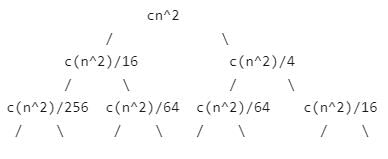Test: Recurrence Relations - Computer Science Engineering (CSE) MCQ
15 Questions MCQ Test - Test: Recurrence Relations
Consider the following recurrence relation

The value of T(m2) for m ≥ 1 is

The solution to the recurrence equation T(2k) = 3 T(2k-1) + 1, T (1) = 1, is:
Select the correct asymptotic complexity of an algorithm with runtime T(n, n) where
T(x, c) = Θ(x) for c <= 2,
T(c, y) = Θ(y) for c <= 2, and
T(x, y) = Θ(x+y) + T(x/2, y/2)
T(x, c) = Θ(x) for c <= 2,
T(c, y) = Θ(y) for c <= 2, and
T(x, y) = Θ(x+y) + T(x/2, y/2)
Consider the recurrence relation a1 = 8, an = 6n2 + 2n + an-1. Let a99 = k x 104. The value of K is _____ Note : This question was asked as Numerical Answer Type.
When n = 22k for some k ≥ 0, the recurrence relation
T(n) = √(2) T(n/2) + √n, T(1) = 1
evaluates to :
Standard planning algorithms assume environment to be __________.
The worst-case running time of Merge sort algorithm is described by the following recurrence relation :

Given recurrence equation evaluates to -
What is the time complexity for the following C module? Assume that n>0 . int module(int n) { if (n == 1) return 1; else return (n + module(n-1)); }
For parameters a and b, both of which are ω(1), T(n)=T(n1/a)+1, and T(b)=1. Then T(n) is
Consider the following three functions.
f1 = 10n
f2 = nlogn
f3 = n√n
Which one of the following options arranges the functions in the increasing order of asymptotic growth rate?
Consider the following recurrence relation.

Which one of the following options is correct?
What is the worst-case number of arithmetic operations performed by recursive binary search on a sorted array of size n?
What is the value of following recurrence.
T(n) = T(n/4) + T(n/2) + cn2
T(1) = c
T(0) = 0
Where c is a positive constant
The running time of an algorithm is represented by the following recurrence relation:
if n <= 3 then T(n) = n
else T(n) = T(n/3) + cn
Which one of the following represents the time complexity of the algorithm?
(A) (n)
(B) (n log n)
(C) (n^2)
(D) (n^2log n)
Consider the following recurrence. T(n) = T(√n) + θ(Log Log n) What is the value of recurrence?
(A) θ( (Log Log n)2)
(B) θ(Log Log n)
(B) θ(n)
(B) θ(Log Log Log n)

















